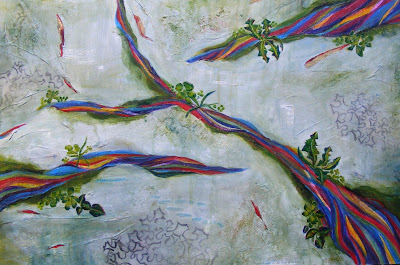It was Anne of Green Gables who first taught my nine year old self to love words.
It was Anne's performance of "The Highwayman" at the White Sands Hotel that inspired me to memorize portions of "The Highwayman" and perform it with great enthusiasm in the privacy my bedroom. And it was Anne's literary ambitions that fuelled the writing of my own poetry on all the beauties of trees blowing in ferocious winds under the moonlit skies, written in the illegible scrawls of newly learned cursive. I longed to be a writer, and a writer of the type who spends most of her time wandering in a daze through dewy fields waxing eloquent on the virtues of moonlight. This was a clearly pragmatic plan.
In the 1985 film of
Anne of Green Gables, Anne's love for words open the first scene as she wanders through a forest, reciting words from Tennyson's "The Lady of Shalott" to herself, "willows whiten, aspens quiver/ little breezes dusk and shiver..."
But with the shriek of "Anne, Anne!" she is brought from the heights of poesy to the depths of prosaic life replete with poverty, abusive guardians and three sets of squalling twins under the age of five to look after.
It is a rude awakening.
"The Lady of Shalott" seems a fitting subtext to Anne's life. The Lady of Shalott, the artist living on an island within sight of Camelot, whose only glimpses of that land are through mirrored reflections that she transposes into a woven web. Hers is a reality twice removed. Though she "still delights/ to weave the mirror's magic sights," on occasion delight is replaced with isolation and she sighs "I am half sick of shadows."
Half sick of shadows. Although she is present in the world, sometimes heard singing by "reapers, reaping early in among the bearded barley," hers is a shadowed existence so solitary and isolated that if she but look to the "water lily bloom"and turn to Camelot a curse will befall her.
And so it does when Sir Lancelot's image flashes across her crystal mirror. With a turn of her head towards the prospect of life beyond shadows, she carries out her final artistic act: she makes herself a bier upon which she floats dying down the river towards Camelot.
And that, my friends, is the plight of the artist who dares not only to see but to act in the world.
It is a tempting thing to be an artist, a creative type, who retreats from the world they take delight in. From Tennyson one gathers the impression that the ethereal realm of crystal mirrors and magic webs is where life is lived, and that dull prosaic world is the world that leads to death. But I disagree.
Anne and her friends act out the scene of the Lady of Shalott's death with comic earnestness, striving to leave through imagination the dull realm of harvests and spelling bees, gossip and housekeeping.
But reality in the form of a leaky raft catches up to them and a romantic river death looses its appeal when that river is full of weeds and the only Sir Lancelot in sight is an annoying boy from school. The Lady of Shalott clearly had it better, even though she died and Anne was merely helped back to shore by the annoying boy.
I think that I would tend to side more with L.M Montgomery than Tennyson in the matter of a life in the shadows. Though as a child I thought that the Anne books all about leading a vivid life of the imagination, I have come to see Anne's as an imaginative life rooted in reality and a sense of humour capable of sensing the dissonance between ideals and reality.
And because I am a grad school student, I simply cannot end a blog post about Anne of Green Gables and the Lady of Shalott without quoting at
least one of my books from school. Currently I am reading a book by Roger Lundin called
Believing Again. At one point Lundin quotes the philosopher Hans-Georg Gadamer who writes in
Truth that the artist and viewer of a piece of art "is never simply swept away into a strange world of magic, of intoxication, and of dream; rather, it is always his own world, and he comes to belong to it more fully by recognizing himself more profoundly in it."
Art, for Gadamer, leads not to an ethereal up-in-the-clouds state of poesy, but straight into the world of spelling bees, gossip and annoying people that Anne strives to escape. Art leads not to isolation, but to deeper engagement.
And so, please rest assured that I have forsaken my childhood dream of wandering impoverished through dewy fields writing adjective-laden poetry, occasionally flung into the depths of artistic despair by a rejection slip from a magazine. While I like to keep a strong hold on my adjectives and may on occasion delve into the depths of despair, my hope is that words and pictures charged with beauty will lead me towards and not from the everyday prose of life.





